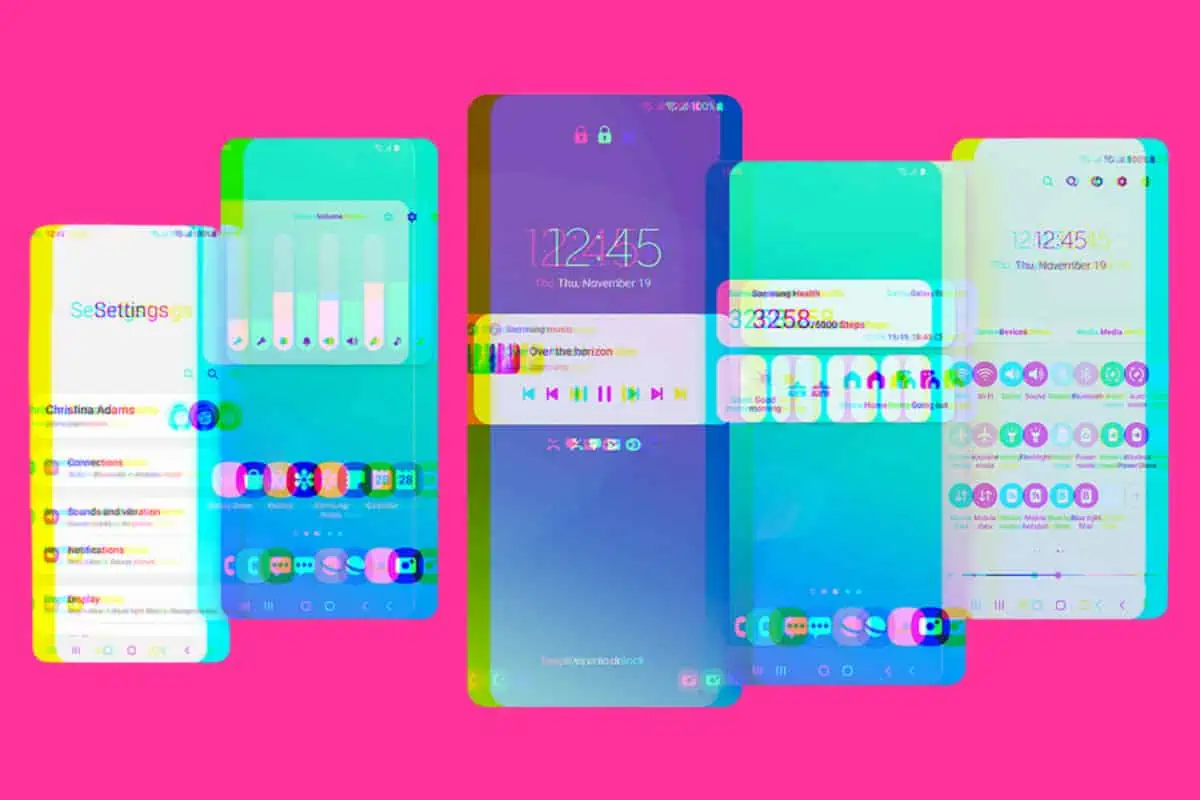There’s been a slew of One UI updates over the years. In this guide, we’ll take a look at ALL the One UI updates from Samsung
Table of Contents
Samsung’s One UI is one of the best Android skins on the market. In some respects, the latest version, One UI 5.1, is even better than Google’s Pixel UX – it has more features, more intuitive elements, and loads of customisation options.
But things weren’t always this way. Back when One UI 1.0 came out, around the time Android 9 first dropped, Samsung hadn’t fully hit its potential with its software design. One UI 1.0 was pretty heavy on the bloatware and it didn’t look as good as later versions.
This was quickly remedied through a raft of updates, going from Android 9 all the way up to Android 13 with the release of One UI 5.1 which, at the time of writing, is by far and away one of the nicest Android skins you can run on a phone today.
One UI Versions: A Quick History
| One UI Version | Android Version | Notable Features |
|---|---|---|
| One UI 1.0 | Android 9 “Pie” | Dark mode, native screenshot editing tools, refinements to Always-On Display, and gesture navigation system |
| One UI 1.1 | Android 9 “Pie” | Minor updates, performance optimization, and camera and facial recognition stability fixes |
| One UI 1.5 | N/A | Native Link to Windows support and other minor updates for Galaxy Smart Watches |
| One UI 2.0 | Android 10 | Refined UI in default apps, Digital Wellbeing, native screen recorder, Trash folder in Files, Dynamic Lock Screen, and harder location permission access |
| One UI 2.1 | Android 10 | Support for Galaxy devices that support 120 Hz refresh rate, Quick Share, Music Share, additional camera modes, and native support for Live Captions |
| One UI 2.5 | Android 10 | New feature additions to the camera, DeX, gesture navigation, and other services |
| One UI 3.0 | Android 11 | Translucent notification panel, brief notifications, new volume controls, enhanced widgets, and smoother animations |
| One UI 3.1 | Android 11 | Improvements to camera features, such as improved touch autofocus and auto exposure controller, and new software implementations, such as Object Eraser, Multi Mic Recording, Eye Comfort Shield, and Private Share |
| One UI 3.1.1 | Android 11 | Multi Window, Split-Screen View for Settings, Labs, BedTime Mode, and other features for Galaxy Z series |
| One UI 4.0 | Android 12 | Customization, privacy, and access to Samsung’s expanding ecosystem |
| One UI 4.1 | Android 12 | Added features like Smart Calendar, option to choose virtual RAM, redesigned palette picker, Smart Widgets, separate Left/Right audio balance, extra brightness toggle, Pro Mode on more cameras, Night Mode portraits, and other minor changes |
| One UI 4.1.1 | Android 12L | Enhancements to multitasking and optimizations for foldable smartphones (Galaxy Z Fold line) and large screen tablets (Galaxy Tab line) |
| One UI 5.0 | Android 13 | Ability to turn off RAM Plus, redesigned lock screen customization, Material You expansion, and refreshed icons |
| One UI 5.1 | Android 13 | Multitasking, weather, new battery widget, settings, Spotify suggestions, camera, and gallery feature improvements |
The first version of Samsung’s One UI launched in 2019 and ran on Android 9. Borrowing many elements and ideas from both iOS and Google’s Pixel launcher, One UI represented Samsung’s renewed focus on making its phone’s software better.
Here’s a timeline of how One UI has evolved since 2019, including all the updates and tweaks Samsung made to each new version of One UI.

One UI 1.0
This version introduced dark mode, native screenshot editing tools, refinements to the Always-On Display, an upgraded Bixby, and new gesture navigation. One UI 1.1 was a minor update that brought camera, fingerprint, and facial recognition stability fixes and performance optimizations.
One UI 2.0
This update, powered by Android 10, provided a skinned Digital Wellbeing experience, a more refined UI in some default apps, a native screen recorder, the new Android 10 gesture system, Dynamic Lock Screen, a Trash folder in Files, and native Android Auto. One UI 2.1 was a minor update that brought support for 120 Hz refresh rate, Quick Share, Music Share, additional camera modes, and native support for Live Captions.
One UI 2.5
Another minor update in the One UI 2.0 series, this version brought new feature additions to the camera, DeX, gesture navigation, and other services.
One UI 3.0
Based on Android 11, this update included a few noteworthy revisions, such as a translucent notification panel, brief notifications, new volume controls, slightly enhanced widgets, and smoother animations and transitions throughout the UI. One UI 3.1 was a minor update that contained many new camera feature improvements and software implementations.
One UI 4.0
Based on Android 12, this update focused on customization, privacy, and access to Samsung’s expanding ecosystem. One UI 4.1 was a minor update that introduced features like Smart Calendar, added option to choose how much virtual RAM is desired, redesigned palette picker, Smart Widgets, separate Left/Right audio balance, extra brightness toggle, Pro Mode on more cameras, Night Mode portraits, and other minor changes.
One UI 5.0
Based on Android 13, this update introduced the ability to turn off the RAM Plus feature, a redesigned way of customizing the lock screen, and expanded Material You to most of Google and Samsung Apps.
One UI 5.1, a minor update of One UI 5.0, contains many new multitasking, weather, battery widget, settings and Spotify suggestions, camera and gallery features improvements, and was pre-installed in the Samsung Galaxy S23 series.
The Latest Version of One UI
One UI 5.1
One UI 5.1 is the latest version of One UI, released in February 2023 with the Samsung Galaxy S23 series. It is a minor update to One UI 5.0, but it brings several new features and improvements to the UI.
One of the most significant changes in One UI 5.1 is the multitasking improvements. Users can now swipe up from the bottom of the screen to open the recent apps screen and easily switch between them.
The new Weather app in One UI 5.1 also offers a refreshed design with more information at a glance, including a new 10-day forecast, air quality, and pollen counts.

The battery widget has also been updated, and it now shows more detailed information about battery usage and estimates. The new settings interface features a more organized layout and a revamped search function that makes it easier to find specific settings.
Additionally, Spotify suggestions are now integrated into the notification shade and lock screen, allowing users to quickly access their favorite songs and playlists.
One UI 5.1 also brings several improvements to the Camera and Gallery apps, including enhanced image remastering and a new color tone option for selfies.
The Info display has been revamped, making it more user-friendly and providing more information. There are also new features such as picture-in-picture mode for video calls and the ability to customize the size of the floating window for certain apps.
One UI Update Support
Not so long ago, Samsung really started drilling down on its support. This was one area where it was really losing ground to Apple with its market-leading support for iPhone.
Samsung began offering three years’ worth of Android updates to select Samsung phones and four years of security updates (including One UI updates).
iPhones get years and years’ worth of iOS updates, whereas most Android phones get two at the very most. Google now offers three years’ worth of Android updates, so Samsung had to match it – and it did, adding in an additional year of security and One UI updates.
Still, the king of Android updates right now is OnePlus. Following the launch of the OnePlus 11, OnePlus confirmed that the OnePlus 11 would four years’ worth of Android updates and five years’ worth of security updates.
This means, in 2024, we could see a similar promise made by Samsung. I say, could, because it isn’t certain. Like Google, Samsung may believe that three years’ worth of Android updates is more than enough.
The devices that are and were included in this renewed approach to support are as follows:
- Samsung Galaxy S21 series and later devices
- Samsung Galaxy Z Fold 3, Z Flip 3, and later devices
- Samsung Galaxy A3x series (A33 and later), A5x series (A53 and later), and A7x series (A73 and later)
Bottom line? So long as you’re running a new Samsung phone, you’ll get three years’ worth of Android updates and four years’ worth of security updates (including One UI updates).
And right now, the best Samsung phone you can buy is the Samsung Galaxy S23 Ultra – read our Galaxy S23 Ultra review to find out why.

